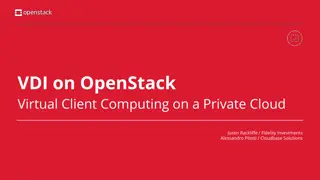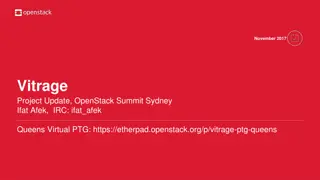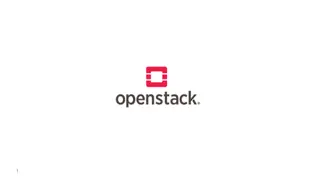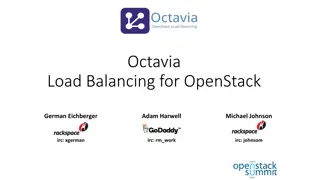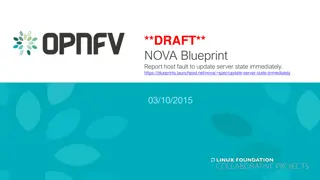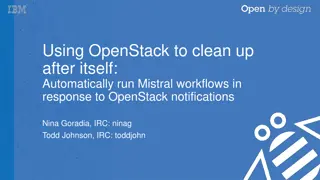Evolution of OpenStack during the Kilo Release Cycle
In the Kilo release cycle, the OpenStack community focused on stability, defined core services, and enabled interoperability with emerging technologies. Key themes included stability, scalability across core services, and the introduction of Identity federation. The community matured by defining core services and expanding usage patterns. User feedback shaped the roadmap, with companies like Walmart and Comcast increasing their OpenStack footprint significantly. The integrated release approach evolved to support innovation around foundational services.
Download Presentation

Please find below an Image/Link to download the presentation.
The content on the website is provided AS IS for your information and personal use only. It may not be sold, licensed, or shared on other websites without obtaining consent from the author.If you encounter any issues during the download, it is possible that the publisher has removed the file from their server.
You are allowed to download the files provided on this website for personal or commercial use, subject to the condition that they are used lawfully. All files are the property of their respective owners.
The content on the website is provided AS IS for your information and personal use only. It may not be sold, licensed, or shared on other websites without obtaining consent from the author.
E N D
Presentation Transcript
During the Kilo release cycle, the OpenStack community tightly defined a stable set of core services, creating a solid platform for interoperability and to integrate emerging technologies 3
OpenStack Kilo Key Themes Stability, scale across core compute, storage and networking services Defined common foundation for OpenStack clouds Tightly Defined Core Rigorous testing standards to ensure consistency across plugin options Identity federation enables hybrid and multi-cloud use cases Interoperability Ironic delivers next generation of bare metal provisioning Solid platform to support existing workloads, and adopt emerging technologies like containers, PaaS and NFV Beyond Virtual Machines 4
Community Continues to Mature Core services defined by Board and community Reached a big milestone defining capabilities and tests for OpenStack core services, to drive interoperability and consistency in downstream market Common usage patterns emerging Companies are deploying OpenStack as the infrastructure standard, or the line, within their organization Ecosystem expanding around the platform to meet needs of diverse workloads and industries, eg complex networking, big data or new dev oriented tools Vertically integrated working groups refine use cases More product management workflows being built into development processes Requirements defined by working groups: Enterprise, Telco, Large deployments, application ecosystem, etc. 5
Users continue to drive roadmap A few speaking in Vancouver: Walmart CERN Comcast eBay/PayPal Adobe TDBank Dreamworks American Express Time Warner Cable TD Bank Symantec NASA JPL Cloud & Heat AVG Superuser Award finalist Comcast grew their OpenStack footprint 500% in a year Read more at superuser.openstack.org 6
Whats Happening with the Integrated Release? Integrated Release terminology became too loaded and binary: Implied this is all of OpenStack , but in reality users would pick & choose components for their clouds Conversely, slowing down expansion of integrated release scope meant not supporting innovation around foundational services Arrival of DefCore created tighter definition and testing of compute, storage and networking services available in OpenStack clouds downstream, a better match to real-world adoption of projects Upstream community now organizing around tighter core, while opening the door for more innovation under the OpenStack community umbrella 7
Key Growth Stats 1,494 contributors affiliated with 169 organizations contributedto Kilo (activity.openstack.org) Contributor Growth 394new features in the Kilo integrated release and common libraries (status.openstack.org/release) Total Number of Features 7,257 bugs fixed during the Kilo release cycle (activity.openstack.org) Bugs Fixed Red Hat, HP, IBM, Mirantis, Rackspace, OpenStack Foundation, Yahoo!, NEC, Huawei and SUSE (activity.openstack.org) Top Companies Committing Code 792,200 strings translated (transifex.com) Translations 113 drivers and plugins supported across the compute, storage and networking capabilities (https://www.openstack.org/marketplace/drivers/) Drivers & Plugins 8
Compute Next generation bare metal provisioning First full release of Ironic, providing increased support for managing hardware Allows for workloads to be placed in the best environment for their performance requirements Already used in production environments like Rackspace OnMetal offerings New API versioning management v2.1 and microversions provide reliable, strongly validated API definitions Makes it easier to write long-lived applications against compute functionality Operational improvements Big improvements to live upgrades when a database schema change is required Better support for changing the resources of a running VM 10
Storage Object Storage Initial availability of erasure codes to provide more efficient and cost-effective storage algorithm Container-level temporary URLs allow time-limited access to a set of objects in a single container, allowing for easy sharing of specific data Improvements to global cluster replication, storage policy metrics, and full Chinese translation Block Storage Major updates to testing and validation requirements for backend storage systems across 70 options Ensures consistency across storage options as well as continuous testing of functionality for all included drivers Attach a volume to multiple compute instances to enable new high availability and migration use cases 11
Networking & Shared Services Networking Load-balancing as a service API version 2 Additional features to support NFV such as portsecurity for OpenVSwitch, VLAN transparent and MTU API extensions Architectural updates to improve scale for future releases Identity Identity federation that can be enabled across public and private clouds to support hybrid workloads in multi-cloud environments by mapping user accounts to many clouds Oslo (Common function library) High Availability improvements through heartbeat monitoring 12



